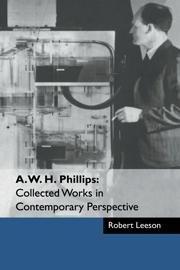Book contents
- Frontmatter
- Contents
- List of contributors
- Foreword by Arthur Brown
- Preface by Robert Leeson
- Part I Bill Phillips: Some Memories and Reflections
- Part II The Phillips Machine
- Part III Dynamic Stabilisation
- Part IV Econometrics
- 36 The Bill Phillips legacy of continuous time modelling and econometric model design
- 37 The published papers
- 38 The influence of A.W. Phillips on econometrics
- 39 An appreciation of A.W. Phillips
- 40 Some notes on the estimation of time-forms of reactions in interdependent dynamic systems
- 41 Cybernetics and the regulation of economic systems
- 42 The estimation of parameters in systems of stochastic differential equations
- 43 Estimation, regulation and prediction in interdependent dynamic systems
- 44 The Walras-Bowley Paper
- 45 Estimation of systems of difference equations with moving average disturbances
- 46 The estimation of continuous time models
- 47 Estimation in continuous time series models with autocorrelated disturbances
- 48 Efficient fitting of rational spectral density functions and transfer functions
- 49 The Lucas Critique: did Phillips make a comparable contribution?
- 50 Models for the control of economic fluctuations
- 51 Statistical estimation for the purpose of economic regulation
- 52 The last paper: a foreshadowing of the Lucas Critique?
- References
- Index of names
- Index of subjects
46 - The estimation of continuous time models
Published online by Cambridge University Press: 04 May 2010
- Frontmatter
- Contents
- List of contributors
- Foreword by Arthur Brown
- Preface by Robert Leeson
- Part I Bill Phillips: Some Memories and Reflections
- Part II The Phillips Machine
- Part III Dynamic Stabilisation
- Part IV Econometrics
- 36 The Bill Phillips legacy of continuous time modelling and econometric model design
- 37 The published papers
- 38 The influence of A.W. Phillips on econometrics
- 39 An appreciation of A.W. Phillips
- 40 Some notes on the estimation of time-forms of reactions in interdependent dynamic systems
- 41 Cybernetics and the regulation of economic systems
- 42 The estimation of parameters in systems of stochastic differential equations
- 43 Estimation, regulation and prediction in interdependent dynamic systems
- 44 The Walras-Bowley Paper
- 45 Estimation of systems of difference equations with moving average disturbances
- 46 The estimation of continuous time models
- 47 Estimation in continuous time series models with autocorrelated disturbances
- 48 Efficient fitting of rational spectral density functions and transfer functions
- 49 The Lucas Critique: did Phillips make a comparable contribution?
- 50 Models for the control of economic fluctuations
- 51 Statistical estimation for the purpose of economic regulation
- 52 The last paper: a foreshadowing of the Lucas Critique?
- References
- Index of names
- Index of subjects
Summary
Chapter 47 is a brief outline of a paper presented at a meeting at Nuffield College, Oxford in 1962. It refers to chapter 48 for details of proposed methods of estimating the parameters of continuous time dynamic models from observations of the variables at equispaced points of time. Chapter 48 is a sequel to chapter 42, an important and influential essay which Phillips had published in Biometrika in 1959.
Although Koopmans (1950b) was the first econometrician to recognise the potential importance of continuous time models in econometrics and Bartlett (1946) had earlier dealt with estimation problems in some simple special cases, it was Phillips in 1959 (chapter 42) who produced the first detailed algorithm for estimating a continuous time model of sufficient generality to be of use in macroeconometric work. Moreover, chapter 42 provided the initial stimulus for work on continuous time methods by other econometricians. In particular, it was the major stimulus to my own work on this subject, which commenced, at the LSE in 1962–3 and has continued for more than thirty years (Bergstrom 1990).
The main contribution of chapter 42 was to show how to derive the parameters of a stochastic differential equation system from a sequence of values of the correlation function at unit intervals. The route that he followed was to first derive the correlation function from its values at unit intervals, next, by taking the Laplace transform of the correlation function obtain the transfer function of dependence of the variables generated by the differential system on the white noise innovations and, finally, obtain the parameters of the differential system from the transfer function.
- Type
- Chapter
- Information
- A. W. H. Phillips: Collected Works in Contemporary Perspective , pp. 445 - 448Publisher: Cambridge University PressPrint publication year: 2000



